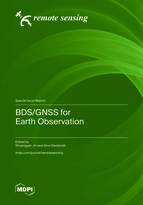BDS/GNSS for Earth Observation
A special issue of Remote Sensing (ISSN 2072-4292). This special issue belongs to the section "Engineering Remote Sensing".
Deadline for manuscript submissions: closed (31 July 2022) | Viewed by 43862
Special Issue Editors
Interests: GNSS meteorology; remote sensing; space/planetary exploration
Special Issues, Collections and Topics in MDPI journals
Interests: Galileo; GLONASS; GPS; GNSS; CORS; remote sensing; geomatics; dam displacements
Special Issues, Collections and Topics in MDPI journals
Special Issue Information
Dear Colleagues,
Global Navigation Satellite Systems (GNSSs) have drawn the attention of scientists all over the world for wide-ranging earth monitoring and investigatory applications. At the end of 2020, there are several fully global operational satellite navigation systems, such as the Chinese BeiDou Navigation Satellite System (BDS), European Galileo, Russian GLONASS and American GPS. Furthermore, many other regional GNSS systems will be available in the next few years, such as the Indian Regional Navigation Satellite System (IRNSS/NavIC), the Japanese Quasi‑Zenith Satellite System (QZSS), and the Regional South Korean Positioning System (KPS), which will hold massive potential for applications in the scientific community. For example, the ground-based and space-borne GNSS receivers can measure the ionospheric total electron content (TEC) that routinely monitors the global ionospheric climate and weather (GNSS-Ionosphere). The dense TEC observations record regional ionospheric perturbations due to earthquakes/tsunamis, or geomagnetic storms, typhoon and eclipses. The GNSS Reflectometry (GNSS-R) from a low Earth-orbiting satellite can retrieve environmental parameters over sea ice, land and ocean.
GNSSs are today a major technique in the field of earth observations. With continuous improvements and developments in terms of performance, availability, modernization and hybridizing, GNSSs will inevitably become involved in more future applications. The aim of this Special Issue is to present the latest state-of-the-art findings, which include, but are not limited to, the following:
- Troposphere and ionosphere observations, modeling and assimilation from ground and space receivers;
- Theories and methods of multi-GNSS NRTK, PPP and PPP-RTK;
- Analyzing errors, systematic effects and noise in GNSS solutions;
- Surface-loading GNSS observations from atmosphere, hydrology and loading;
- GNSS-Reflected signals and applications;
- Geohazard observation and warning from GNSS.
Prof. Dr. Shuanggen Jin
Dr. Gino Dardanelli
Guest Editors
Manuscript Submission Information
Manuscripts should be submitted online at www.mdpi.com by registering and logging in to this website. Once you are registered, click here to go to the submission form. Manuscripts can be submitted until the deadline. All submissions that pass pre-check are peer-reviewed. Accepted papers will be published continuously in the journal (as soon as accepted) and will be listed together on the special issue website. Research articles, review articles as well as short communications are invited. For planned papers, a title and short abstract (about 100 words) can be sent to the Editorial Office for announcement on this website.
Submitted manuscripts should not have been published previously, nor be under consideration for publication elsewhere (except conference proceedings papers). All manuscripts are thoroughly refereed through a single-blind peer-review process. A guide for authors and other relevant information for submission of manuscripts is available on the Instructions for Authors page. Remote Sensing is an international peer-reviewed open access semimonthly journal published by MDPI.
Please visit the Instructions for Authors page before submitting a manuscript. The Article Processing Charge (APC) for publication in this open access journal is 2700 CHF (Swiss Francs). Submitted papers should be well formatted and use good English. Authors may use MDPI's English editing service prior to publication or during author revisions.
Keywords
- GNSS
- NRTK
- PPP
- Geodesy
- Geohazards
- GNSS Meteorology
- GNSS Ionosphere
- GNSS-Reflectometry
Related Special Issue
- BDS/GNSS for Earth Observation: Part II in Remote Sensing (7 articles)







